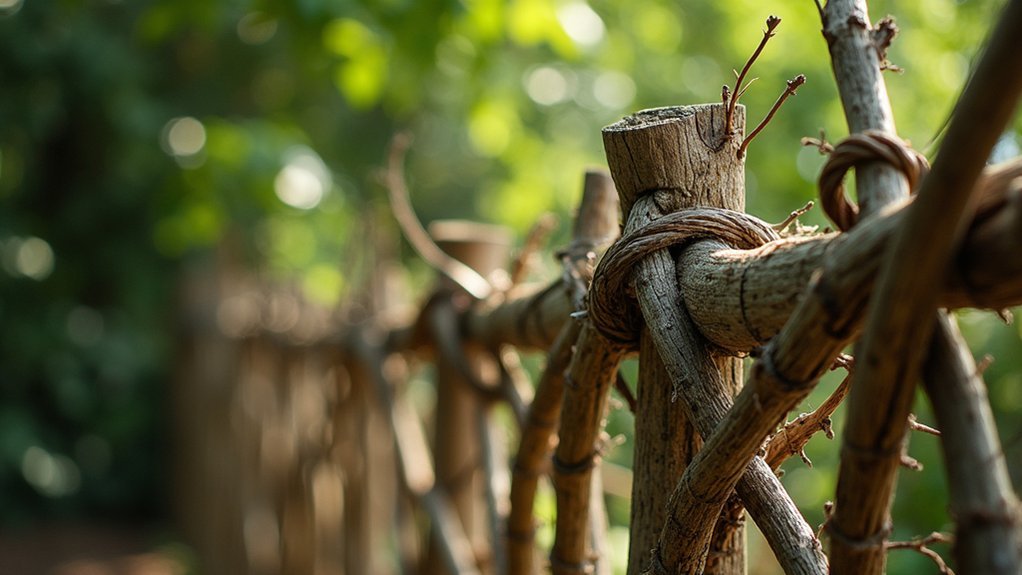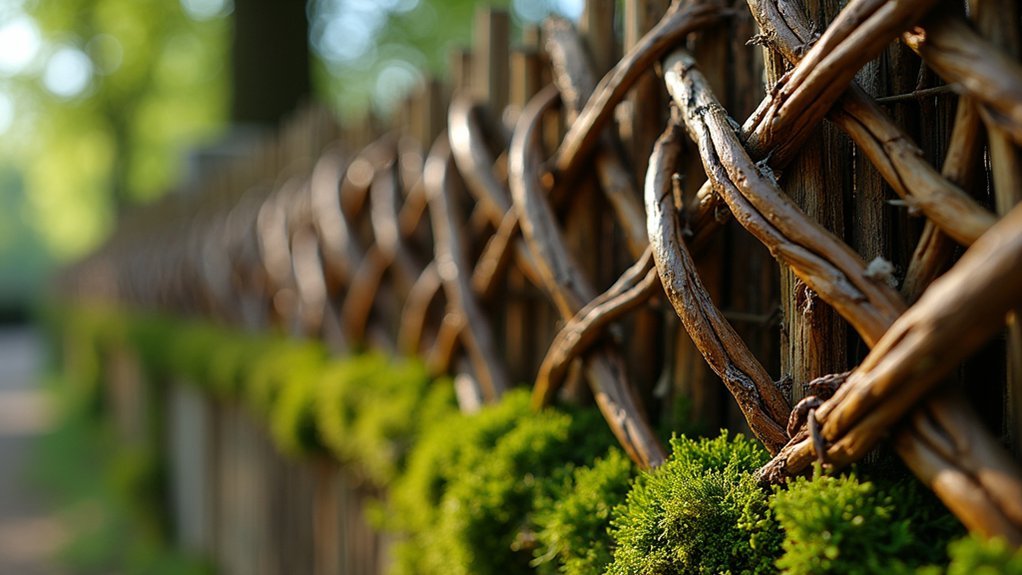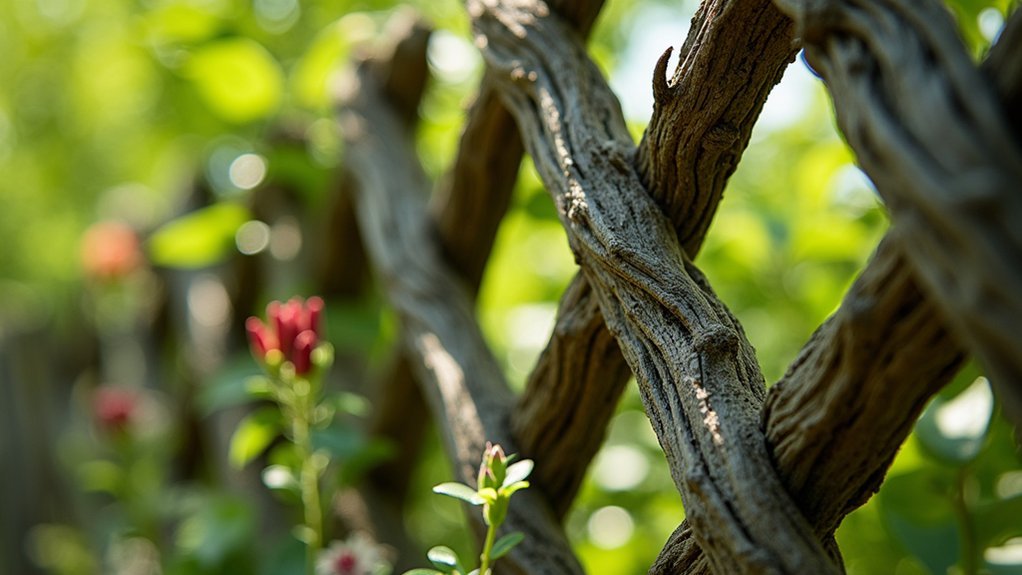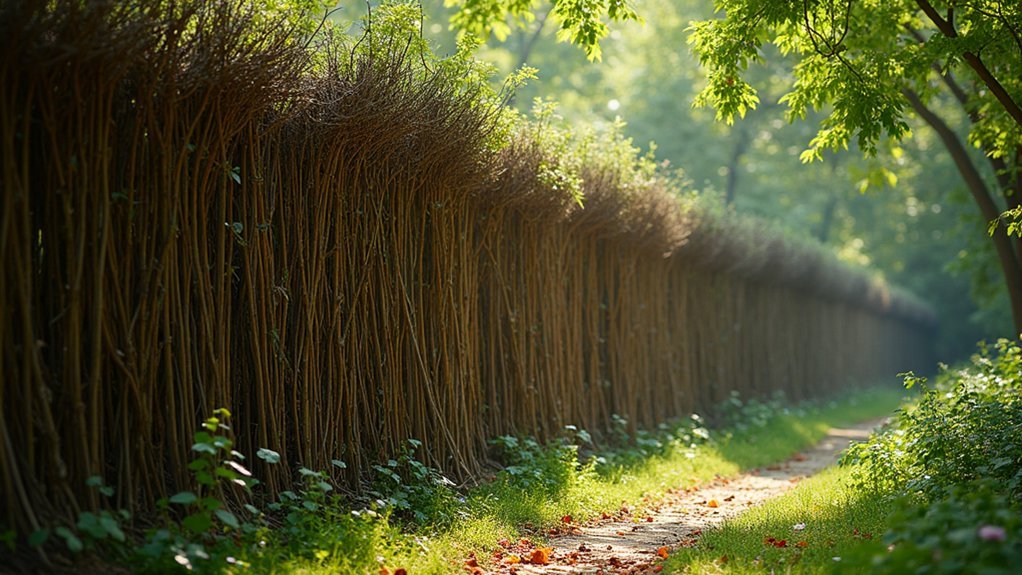Ancient willow fencing endures today because it offers a perfect blend of practicality and sustainability. You’ll find that these living barriers combine traditional Celtic craftsmanship with ecological benefits, providing habitats for wildlife while sequestering carbon. Their natural flexibility withstands storms better than rigid alternatives, and the self-grafting ability creates remarkably strong boundaries. Modern landscapers value willow fencing for its rapid growth, aesthetic appeal, and connection to ancestral wisdom that continues to prove its worth.
9 Second-Level Headings for “Why Ancient Willow Fencing Endures Today”

While modern fencing options abound, ancient willow fencing continues to captivate gardeners and landscapers worldwide.
You’ll discover why this traditional technique remains relevant through these essential aspects:
Unmatched Strength and Longevity
Living Architecture in Your Garden
Ecological Benefits Beyond Boundaries
Practical Maintenance Through Traditional Methods
Cultural Heritage in Modern Landscapes
Each of these elements highlights why living willow structures stand the test of time.
When you install a willow fence, you’re not just creating a boundary—you’re establishing a dynamic, growing system.
As an eco-friendly alternative to conventional fencing materials, willow offers impressive growth rates of up to 2.7 cm daily, quickly forming substantial barriers with trunk diameters reaching 8-10 inches while supporting biodiversity and honoring ancient practices simultaneously.
Historical Roots of Willow Fencing
You’ll find willow fencing’s origins in ancient Celtic cultures, where these sacred trees provided both spiritual meaning and practical barriers.
Medieval farmers expanded these techniques, developing the woven patterns still recognizable in countryside landscapes today.
These early craftspeople discovered that willow’s natural flexibility made it ideal for creating durable barriers, employing weaving methods that blended function with artistry.
Celtic Sacred Uses
Before the first willow wicker was woven into modern garden fencing, ancient Celts recognized the sacred power of this remarkable tree.
You’ll find that willow held a profound place in Celtic spirituality, symbolizing protection and healing in their rituals and ceremonies.
These ancient societies created living structures from willow that served both practical and spiritual purposes. They crafted fences that formed natural barriers for agriculture while maintaining their connection to ancestral heritage.
The sacred willow’s flexibility and durability made it perfect for these applications.
What’s fascinating is how the Celts believed willow possessed magical qualities linking them to the underworld and regeneration.
This dual nature—practical yet deeply spiritual—explains why they integrated willow so thoroughly into their landscape and cultural practices.
Medieval Barrier Evolution
As Europe emerged from the Dark Ages, willow fencing techniques evolved from their Celtic origins into sophisticated medieval barrier systems.
During the medieval period, landowners discovered that willow’s remarkable flexibility and growth potential made it ideal for creating living fences that strengthened over time.
You’ll find evidence of this practice in historical records dating back to the 12th century, when these living willow structures served dual purposes. They effectively contained livestock and marked property boundaries while enhancing the aesthetic appeal of estates and gardens.
Craftspeople wove intricate patterns that combined functionality with decorative elements, creating barriers that were both practical and visually appealing.
The technique was carefully preserved and passed through generations, demonstrating how these living fence systems adapted alongside changing agricultural practices and societal needs throughout the medieval era.
Traditional Crafting Techniques
The ancestral roots of willow fencing techniques stretch deep into Celtic history, where craftsmen revered the willow as more than mere material. They recognized its sacred properties, harnessing its remarkable flexibility and strength to create lasting barriers.
You’ll find that traditional techniques centered on weaving long, straight rods together, creating structures that strengthened naturally as the live willow grafted itself over time.
Craftsmen practiced pollarding—cutting back the tops of trees to encourage fresh shoots—ensuring sustainable materials for generations.
Various species like Salix viminalis allowed artisans to adapt their designs to different environments.
These methods weren’t merely practical; they represented sophisticated understanding of natural properties, allowing fences to serve dual purposes of livestock containment and privacy screens across rural European landscapes.
Ecological Benefits of Living Barriers
You’ll find that living willow barriers transform your garden into vibrant wildlife havens, attracting beneficial insects, birds, and small mammals that enrich local ecosystems.
These natural structures work tirelessly as carbon-capturing powerhouses, actively sequestering CO2 throughout their growing life, contributing meaningfully to climate change mitigation efforts.
Beyond their beauty, your living willow fence serves as a multifunctional ecological asset, simultaneously reducing soil erosion and creating natural windbreaks that protect vulnerable plants.
Wildlife Havens
While modern fencing options abound, living willow barriers stand apart as vibrant ecosystems rather than mere boundaries.
You’ll find these living structures provide vital habitats for diverse wildlife, from nesting birds to beneficial insects and small mammals, greatly enhancing your garden’s biodiversity.
The dense, intertwined branches create natural windbreaks, establishing protected microclimates that shelter vulnerable species while supporting varied plant communities.
When spring arrives, flowering catkins emerge as essential food sources for pollinators, particularly bees seeking early-season nectar.
What makes living willow particularly versatile is its dual function: the barriers effectively deter larger wildlife like deer and rabbits while simultaneously nourishing other species through their foliage.
This balance, combined with willow’s soil-enriching properties and erosion control, creates a regenerative system that supports your local ecosystem year-round.
Carbon-Capturing Properties
Unlike rigid, manufactured fencing materials that contribute to carbon emissions during production, living willow structures actively fight climate change by sequestering substantial amounts of carbon dioxide from the atmosphere.
Each willow tree in your fence can capture approximately 22 kg of CO2 annually as it grows, making your garden boundary a powerful carbon sink.
The carbon-capturing properties extend beyond the visible structure.
As willows develop, their extensive root systems enrich soil health, increasing organic matter content through natural decomposition processes.
You’ll notice improved soil structure and reduced erosion during heavy rainfall, as roots hold earth firmly in place.
Traditional Weaving Techniques Preserved

As historical practices slowly fade in our modern world, traditional willow fencing techniques have endured through dedicated artisans who preserve ancient methods.
When you explore these living willow structures, you’ll discover techniques with roots in ancient Celtic traditions, where the flexible stems were considered sacred.
Today’s practitioners honor this cultural heritage by teaching:
- The classic “wattle” weaving pattern that creates durable barriers
- Methods for interlacing fresh cuttings that naturally graft together
- Techniques for establishing living fences that strengthen over time
- Historical approaches that blend functionality with aesthetic beauty
You’ll find community workshops where these skills are actively passed down, ensuring that traditional weaving techniques remain relevant in contemporary landscapes.
This preservation effort connects you directly to centuries-old craftsmanship that continues to evolve while respecting its origins.
Seasonal Maintenance and Long-Term Care
Though living willow fences offer remarkable beauty and functionality, they require consistent care to thrive throughout the seasons. You’ll need to implement regular pruning every winter to control growth and maintain the fence’s shape. Space your willows approximately two feet apart when planting to guarantee proper density as they mature.
| Season | Maintenance Task | Purpose |
|---|---|---|
| Spring | Pest monitoring | Prevent red scale infestations |
| Summer | Regular watering | Support root development |
| Fall | Stability assessment | Identify structural issues |
| Winter | Coppicing/pruning | Control growth patterns |
| All seasons | Health checks | Guarantee long-term health |
Consistent seasonal maintenance guarantees your living fence remains robust and visually appealing for years. During dry periods, especially in the first few months after planting, additional watering is essential to establish strong roots that support the fence’s longevity.
Modern Applications in Sustainable Landscaping

Beyond seasonal care, willow fencing has found remarkable new life in contemporary sustainable landscaping.
You’ll discover that living willow structures offer both practical and environmental benefits that align perfectly with modern eco-conscious approaches.
When you incorporate willow fencing into your landscape design, you’ll enjoy:
- Natural barriers that effectively contain livestock while creating habitats that enhance biodiversity
- Carbon sequestration benefits that actively contribute to climate change mitigation efforts
- Rapid establishment of functional boundaries, with species like Salix viminalis growing to impressive heights within months
- Dual-purpose installations that serve as attractive windbreaks and noise barriers in both urban and rural settings
These sustainable landscaping elements not only provide aesthetic appeal but also deliver practical soil stabilization and erosion control without requiring chemical interventions.
Wildlife Habitat Creation Through Living Fences
When you establish a living willow fence on your property, you’re actually creating a thriving wildlife sanctuary right in your own backyard.
These natural structures offer essential shelter and nesting sites for insects, birds, and small mammals within their dense, intertwining branches.
Your living willow doesn’t just function as a barrier—it becomes an ecosystem that supports biodiversity.
In spring, flowering catkins emerge, providing vital food for bees and other pollinators.
Throughout summer, the lush foliage creates cooler microhabitats where diverse organisms can flourish.
As your fence matures, it evolves into a complex wildlife habitat creation system where various plant species thrive alongside the willow structure.
You’ll witness firsthand how this ancient fencing technique serves both practical and ecological purposes, transforming your landscape into a sanctuary that supports local wildlife year-round.
Cultural Significance Across Different Regions

The cultural significance of willow fencing extends far beyond its practical applications, weaving itself into the very fabric of human civilization across continents. When you explore traditions worldwide, you’ll discover how deeply this native species has influenced diverse societies.
- In Celtic traditions, willow was sacred, symbolizing protection and growth, often integrated into living architecture like willow tunnels.
- Irish and British communities preserved weaving techniques for generations, maintaining heritage skills that support sustainable living.
- Ancient Chinese practices utilized willow in harmony with nature, demonstrating its global appeal as an eco-friendly building material.
- Modern community projects revive these traditions through workshops, connecting past wisdom with contemporary environmental values.
This cultural reverence explains why willow fencing techniques have endured through centuries despite technological advances.
Structural Integrity and Weather Resistance
While ancient societies honored willow’s cultural significance, they also recognized its practical advantages in construction. You’ll find living willow fences demonstrate exceptional structural integrity, withstanding nature’s fury when other materials fail. The secret lies in willow’s natural flexibility—bending rather than breaking during storms.
| Property | Benefit | Result |
|---|---|---|
| Rapid growth (2.7 cm/day) | Quick establishment | Faster reinforcement |
| Natural flexibility | Absorbs impact | Prevents breakage |
| Self-grafting ability | Creates unified structure | Enhanced strength |
The intertwined growth creates a dense barrier that serves as an effective windbreak for your garden. When willows grow close together, they naturally graft, forming a cohesive living structure with remarkable weather resistance. This natural defense against decay means your willow fence will continue protecting your space for years with minimal maintenance.
Frequently Asked Questions
Is Willow Good for Fencing?
Yes, willow’s an excellent fencing choice. You’ll love its fast growth rate, natural strength when intertwined, and ability to create living barriers. It’s sustainable, deer-resistant, and promotes biodiversity in your landscape.
How Long Do Willow Structures Last?
Your living willow structures can last 10-30 years when properly maintained. They’ll constantly regenerate themselves through their strong growth habit, especially if you’re diligent with regular pruning and coppicing to enhance their durability.
How Long Does It Take to Grow a Willow Fence?
You’ll see your willow fence establish in 1-3 years. It’ll show significant growth in the first season, with willows growing over an inch daily under ideal conditions, reaching about 4 feet by year two.
What Type of Willow Is Used for Fences?
You’ll primarily want Salix viminalis for your fence due to its fast growth and straight stems. You can also use Salix purpurea or Salix alba if you’re looking for different colors in your living fence.
In Summary
By embracing willow fencing in your landscape, you’re connecting to centuries of sustainable tradition. You’ll find it’s more than just a boundary—it’s a living ecosystem that supports wildlife while providing beauty and structure. As you care for your willow fence, you’re preserving ancient techniques while creating something that will adapt and thrive for generations, just as it has throughout human history.





Leave a Reply